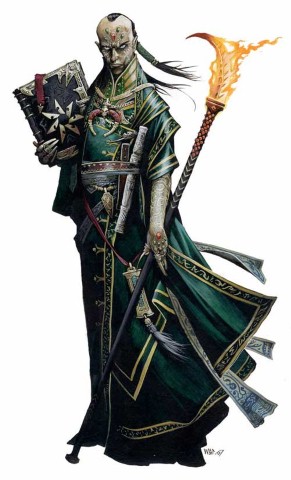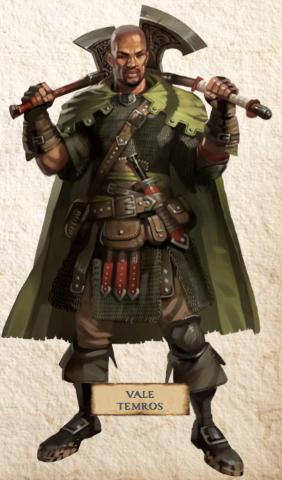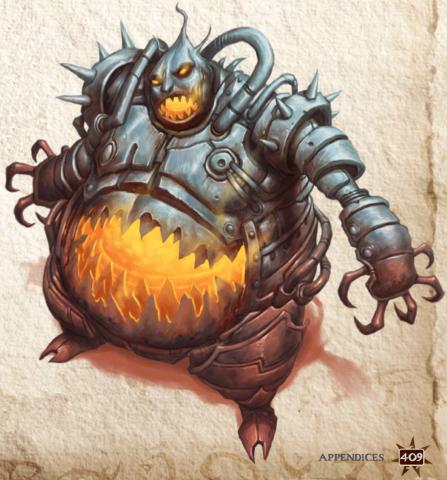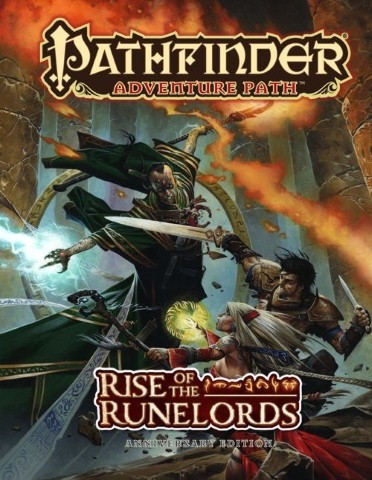Rise of the Runelords is what started it all for Pathfinder. As the very first Pathfinder Adventure Path, it set the tone for everything that followed. Don’t think that is hyperbole; this isn’t just the first peek at the world of Golarion but also the first time that Paizo’s now-iconic goblins appeared, springing fully grown from the heads of James Jacobs and Wayne Reynolds. You can see the tone that extends throughout the rest of the Pathfinder line start here; spooky cults, ancient witch-kings, politics among tribes of monsters, long forgotten ruins; all the bricks that lay in the foundation of the game are quarried here.
Now there is a nice fat Anniversary Edition of it, and a whole set of miniatures devoted to the NPCs and monsters within. It is a good day to be a Pathfinder player!
 I will only speak of things in the vaguest of terms; I want you to be able to read this and get excited for Rise of the Runelords without giving anything away. First, for the players, let me say this: talk to the NPCs. Develop relationships with them. This isn’t a story of generic barkeeps, bland farmers and faceless aristocrats; the people you will meet have stories, and you never know who you might bump into again at a crucial moment. Make friends, make enemies, but this is a story that will reward your level of investment with appropriate narrative twists. Too often games can fall into the trap of only caring about player characters and discounting everyone else; this campaign, however, is one that nurtures the “role” in roleplaying.
I will only speak of things in the vaguest of terms; I want you to be able to read this and get excited for Rise of the Runelords without giving anything away. First, for the players, let me say this: talk to the NPCs. Develop relationships with them. This isn’t a story of generic barkeeps, bland farmers and faceless aristocrats; the people you will meet have stories, and you never know who you might bump into again at a crucial moment. Make friends, make enemies, but this is a story that will reward your level of investment with appropriate narrative twists. Too often games can fall into the trap of only caring about player characters and discounting everyone else; this campaign, however, is one that nurtures the “role” in roleplaying.
While I was reading through Rise of the Runelords, a few character concepts just jumped out at me. That is the hallmark of a good module, ultimately—if you can look through it and see how you would negotiate the various branches and snake-hands, or how you would tweak it to fit your campaign. Is there a more honest piece of critique that anyone can offer? So, here are a few pitches. Think of them as recommendations. Brainstorms. Not spoilers; just the sort of friendly nudge that could help your character eke the most out of this campaign. These are just “hooks” for characters; there is plenty of room to incorporate it into whatever sort of person you feel like playing, but follow my advice and you will have emotional and thematic resonance with the adventure path.
 The Rune Mage: In the appendix of the book there are the rules for Thassilonian Specialists—wizards who specialize in a specific new way. The rules are balanced and they are elegant; if you are a player ask your GM about them, and if you are running the game, suggest it to the player thinking about making a magic-user. The rune schools are each associated with a sin and a virtue, so options are available for even the most heroic or villainous party. In a campaign named Rise of the Runelords, being a rune mage will give you the chance to delve into the secrets of your order…and perhaps become one of the legendary runelords yourself.
The Rune Mage: In the appendix of the book there are the rules for Thassilonian Specialists—wizards who specialize in a specific new way. The rules are balanced and they are elegant; if you are a player ask your GM about them, and if you are running the game, suggest it to the player thinking about making a magic-user. The rune schools are each associated with a sin and a virtue, so options are available for even the most heroic or villainous party. In a campaign named Rise of the Runelords, being a rune mage will give you the chance to delve into the secrets of your order…and perhaps become one of the legendary runelords yourself.
The Giant Slayer: I know the pain of playing a ranger who specializes at first level in a foe that is out of reach for lower level parties, but hear me out. Even if you take it as your second favored enemy, just build in some giants into your background. This campaign is designed with a continuity to the enemies; the social web between the monsters is cogent, which means that once you start fighting giants, you’ll get your chance to work your way up the whole tree, from the lowliest branches to the loftiest heights. Even if you don’t have Favored Enemy and just hate giants, you’ll have plenty of chances to put notches in your “I Swat Seven” belt all the way through the end of the campaign.
 Enemy of the Mother of Monsters: You can’t go wrong hating Lamashtu in most Pathfinder games, but Rise of the Runelords provides plenty of opportunity for a cleric, paladin, or inquisitor to have a holy crusade against her minions. Or, heck, there is no need to play a divine class, even; there is no pre-requisite to hating Lamashtu. Playing an evil campaign? Well, there are plenty of ways to flip the script; why not be a member of the cult of Lamashtu in an unholy crusade against heretics? Ask your Game Master about qualifying for the “Lamashtu’s Mark” feat.
Enemy of the Mother of Monsters: You can’t go wrong hating Lamashtu in most Pathfinder games, but Rise of the Runelords provides plenty of opportunity for a cleric, paladin, or inquisitor to have a holy crusade against her minions. Or, heck, there is no need to play a divine class, even; there is no pre-requisite to hating Lamashtu. Playing an evil campaign? Well, there are plenty of ways to flip the script; why not be a member of the cult of Lamashtu in an unholy crusade against heretics? Ask your Game Master about qualifying for the “Lamashtu’s Mark” feat.
For Game Masters, here’s the best piece of advice I can think of: read the whole thing through before you go back and start the first adventure. The various elements of the story make sense with each other, and if you see something that doesn’t, dig a little deeper and I bet you’ll find the piece of the puzzle that makes it “click.” There are a number of moving pieces and alliances, but that all adds to the verisimilitude. Once you have a decent grasp on the various factions and factors at work, I urge you to meddle. Tweak it, twist it, and above all evolve it in response to what your players do.

Because Rise of the Runelords has a sense of coherency, it can take major modification without falling apart. Don’t be afraid to have the dungeon’s “big bad” retreat; you can always put them in the next part of the adventure. If the players keep regrouping, don’t hesitate to have the lieutenant call their superior in chain of command for reinforcements. The organic nature of the campaign means that you can stretch it like taffy and it won’t come apart in your hands. The adventure path is clever and inventive which means that you have plenty of chances to build off that, to take an idea and run with it. Another hallmark of good writing, right there; Rise of the Runelords will inspire your storytelling.
Mordicai Knode has his greedy eyes on those pre-painted minis; they are just so cool looking, aren’t they? That is more than just the Rune of Greed working on him. You can follow Mordicai on Twitter and Tumblr.











I was just re-reading some of it last night, & thinking about which lower-level Big Bads I would play to the hilt & try to let escape so I could level them up to bedevil higher-level parties later.
They made the seven rune schools into specialist wizards? Now that is very, very slick. We just need is a prestige class called master of sin or master of virtue that uses all 7 runes to rule over Thassilon. That would potray Xin quite well. Perhaps two master weapons to represent sin as the ultimate expression of leadership, since each Runelord had his personal weapon and the sword for his or her champion.
The first one that comes to my mind for a recurring bad guy (or gal) is the corrupted aasimar. She could compete with Mokmurian for Kaurzog (sp)’s favor. His rebirth of greed could fund hordes of women willing or unwilling (given the amount of slaves he can bring with the time portal) to bear children for the greater glory of Lamashtu. It would also lead to more lamia following her glory and the power of the runelords.
2. stormcrow27
Have you played the campaign? From what you say, you sound like you have, so I’m going to talk to you from that vantage– be warned anyone else, this comment has SPOILERS. Okay, so; yeah, they made the rune schools into specialists; it is very slick, & I want to play one even in a non-Runelords campaign. Very fun, very “old school.” Elegant, too. I hear you on the Prestige Classses; maybe there should be a bunch? “Master of Sin” but also “Lord of Greed” & “Dame of Wrath” or something? I’m thinking of the Prestige Classes in the old Book of Vile Darkness…oh & I guess there could be good guy versions…
See, but right…you came up with a character pitch, boom, just that easy! That is a hallmark of good fiction, I think– it makes you go “welllllll if I was in Westeros I would probably be…well, I want to say Targaryen but I’m probably more a Stark…” or whatever.
Also! I got the “Skinsaw Man” miniature, along with a certain other miniature that sort of matches the Skinsaw Man…if you know what I mean…
ROTR was powerful enough that it inspired a bunch of middle schoolers and their drama teacher to convert Burnt Offerings into a play. Very, very few people would even go that far for fiction. It’s also the best Adventure Path series that would lend itself to animation (good animation, not horrible renditions such as the Dragons of Autumm Flame).
I have all of the old campaign modules, but I have never had a chance to play it, mostly since I have to run everything for my current group. I did run the sixth portion tied into a odd group for 3.5 before Pathfinder was released, but they never went past the the first encounter due to lack of interest. It’s next on my list to run for my current group, after they complete Kingmaker.
What impresses me the most was the combination of themes in the last module, especially the Chinese influence and the homages to HP Lovecraft. Karzoug and his servants make for wonderfully creepy/powerful encounters, plus they have a new and old feel with the rune giants gathering his forces to sweep down upon Avistan once he gets enough souls in the runewell. It reminded me of the older Return to the Temple of Horrors plot, for Acerak to regain his form by draining the souls of worthy foes, or unworthy mortals by sheer murder. Each villain in the series is empowered by a combination of sins, rather then the generic “I want power because my goddess/god/demon lord told me to”, and they all have tragic histories.
That type of 3 dimensional motivation for villains shows in Paizo’s writing. The only other D&D adventure that has that level of characterization is the original Ravenloft.
5. stormcrow27
Fun fact: I know those playwrights! It was one of my player’s brothers; he even had a guess spot in my game once. Anyhow, I totally forgot about it, but yeah! That is a pretty good selling point.